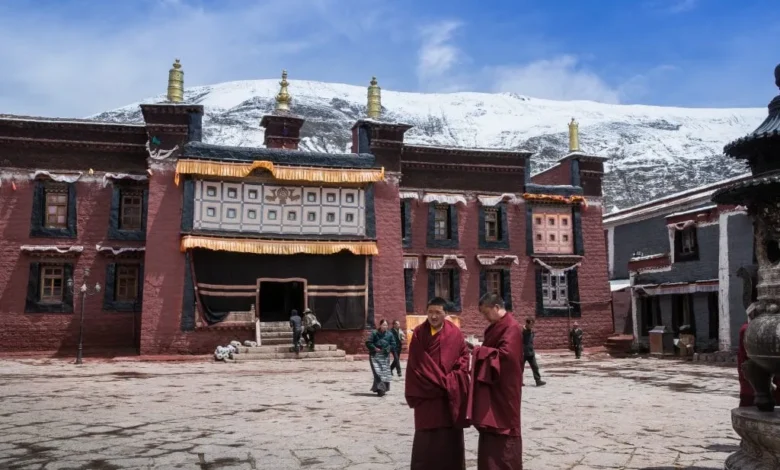The Ancient Library of Tibet: A Deep Dive into Sakya Monastery’s Enigmatic Library

Highlight: The ancient library of Tibet, located at the Sakya Monastery, contains a vast collection of over 84,000 Buddhist scriptures and other works. However, only a small fraction (around 5%) of these texts have been translated and studied so far.
Nestled amidst the majestic peaks of the Himalayas lies the Sakya Monastery, a crown jewel of Tibetan Buddhism and a treasure trove of ancient wisdom. Founded in 1073, this architectural marvel is not only renowned for its stunning murals and serene atmosphere, but also houses a library unlike any other – a repository of knowledge where only a fraction of the secrets have been unlocked.
A Treasure Trove of Texts: A Librarian’s Dream
Imagine towering shelves crammed with thousands of meticulously crafted scrolls. This is the reality within the hallowed halls of the Sakya Monastery library. Estimates suggest the collection holds over 84000 manuscripts, each a potential portal to a bygone era. These texts, known as “pecha,” are traditionally hand-written on dyed paper or palm leaves, often adorned with intricate illustrations and gold lettering.
The Untapped Potential: 95% Waiting to be Heard
The most captivating aspect of the Sakya Monastery library is the sheer volume of untranslated material. Scholars estimate that a staggering 95% of the collection remains shrouded in mystery. These texts are believed to be written in various languages, including Classical Tibetan, Sanskrit, and even ancient dialects. Imagine the wealth of historical, philosophical, and spiritual knowledge waiting to be deciphered!
Beyond Buddhist Scriptures: A Glimpse into the Collection’s Diversity
While a significant portion of the library is dedicated to Buddhist scriptures and commentaries, the collection is far from monolithic. Here, one might find medical treatises detailing herbal remedies, astronomical charts mapping the celestial dance of stars, or even literary works chronicling the lives of bygone heroes. The potential for groundbreaking discoveries in diverse fields is truly awe-inspiring.
Challenges of Translation: A Race Against Time
The process of translating these ancient texts is a monumental task. The fragility of the materials, the complexity of the languages, and the sheer volume of documents all pose significant challenges. Furthermore, the knowledge and expertise required for accurate translation are becoming increasingly rare.
A Collaborative Effort: Unlocking the Past Together
The race to translate the Sakya Monastery library is not a solitary endeavor. Thankfully, institutions around the world are joining forces to decipher these precious texts. Tibetan scholars, linguists, historians, and even technology companies with advanced image recognition software are all playing crucial roles in this ongoing project.
Amazing Facts about the Sakya Monastery
- A Legacy of Scholarship: The Sakya school of Tibetan Buddhism, centered around the monastery, is renowned for its emphasis on logic and debate. This intellectual tradition is reflected in the vast collection of philosophical treatises housed within the library.
- Digital Preservation Efforts: Recognizing the urgency of preserving this invaluable heritage, the monastery has embarked on a digitization project. This initiative aims to create digital copies of the texts, ensuring their longevity and accessibility for future generations.
- More Than Just Texts: The library itself is an architectural marvel. The walls are adorned with vibrant murals depicting scenes from Buddhist mythology, while the building’s very structure reflects the harmonious principles of Tibetan design.
Key Details about the Sakya Monastery library:
- Founded in 1073, the monastery has preserved an enormous archive of sacred Buddhist texts, as well as works on literature, history, philosophy, astronomy, mathematics, agriculture and art.
- The library’s collection includes many volumes written in gold letters, with pages measuring 6 feet long by 18 inches wide. The books are bound in iron and were prepared under orders of Emperor Kublai Khan.
- As of 2022, all 84,000 books have been indexed, and more than 20% have been fully digitized by the monastery. This digitization effort aims to preserve the fragile originals and make the texts more accessible for study.
- Claims that the library contains records dating back 10,000 years are false, as the oldest known writing is only around 5,000 years old. Experts agree this would predate the earliest recorded history.
A Beacon of Hope for the Future
The Sakya Monastery library represents a bridge between the past and the present. As we unlock the secrets held within its walls, we gain a deeper understanding of not only Tibetan history and culture, but also the broader tapestry of human knowledge. With continued collaboration and innovation, the day may come when the full symphony of voices from this ancient library can be heard, enriching our world in ways we can only begin to imagine.
So, the next time you think of Tibet, remember not just the breathtaking landscapes, but also the hidden wisdom waiting to be revealed within the walls of the Sakya Monastery library. This is a story that is far from over, and one that promises to keep us enthralled for generations to come.



